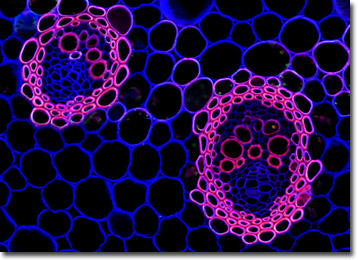 |
 |
 |
|
||||||||||||||||||||||||
 | ||||||||||||||||||||||||
 | ||||||||||||||||||||||||
 | ||||||||||||||||||||||||
Confocal Microscopy Image Gallery
Plant Tissue Autofluorescence Gallery
Buttercup Stem
The bright yellow flowers commonly associated with buttercups are accountable for the common name of the plants, but other bloom colors also occur. A species known as the turban or Persian buttercup is especially valued for the variety of hues its flowers may display and is the type most commonly employed by florists.

Buttercups comprise the genus Ranunculus, which is the Latin term for “little frog.” The genus name is indicative of the preference of buttercups for damp, marshy areas, which are also commonly the haunts of frogs. The plants have a worldwide distribution and are especially common in northern temperate regions.
Buttercups are primitive dicotyledonous plants, evidence suggesting that they date back around 20 million years ago to the Early Miocene Era. Accordingly, the buttercup’s flower structure is rather simple, with each of its components existing as distinct entities rather than being fused into complex organs. Most buttercup flowers have five petals, numerous stamens, and clusters of unconnected pistils that develop into small, one-seeded fruits called achenes. Located at the base of each petal is a scale that traps nectar like a tiny cup. The leaves of the buttercup are deeply cut and are said to resemble crow’s feet, resulting in an alternative name for the plant, which is predominantly called crowfoot in some locales.
Though they can be beautiful, buttercups may also be dangerous. Some varieties are poisonous when consumed fresh and can be fatal to humans, cattle, and other animals. Most species quickly learn to avoid eating the plants, however, because of the bitter taste of the alkaloids they contain. Dried buttercups, which may occasionally be found in hay, do not pose a health threat.
Contributing Authors
Nathan S. Claxton, Shannon H. Neaves, and Michael W. Davidson - National High Magnetic Field Laboratory, 1800 East Paul Dirac Dr., The Florida State University, Tallahassee, Florida, 32310.
